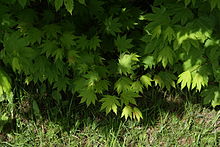Korean Japanese maple
| Korean Japanese maple | ||||||||||||
|---|---|---|---|---|---|---|---|---|---|---|---|---|

Leaves and inflorescences |
||||||||||||
| Systematics | ||||||||||||
|
||||||||||||
| Scientific name | ||||||||||||
| Acer pseudosieboldianum | ||||||||||||
| ( Pax ) Com. |
The Korean Japanese maple ( Acer pseudosieboldianum ) is a large shrub or small tree belonging to the maple genus in the soap tree family (Sapindaceae). The natural range is in Korea, China and in eastern Russia.
description
The Korean Japanese maple is an 8 meter high tree or shrub with a spread or open crown, gray, blackish-striped branches and thin, whitish, frosted young shoots. The paper-like leaves are nine-lobed or el-lobed, 10 to 14 centimeters wide, with a heart-shaped base. The lobes are elongated lanceolate and double serrated. The upper side of the leaf is glossy dark green, the lower side is initially hairy and silky. The petiole is 3 to 5 inches long. The leaves turn yellow, orange or red in autumn and stay on the tree for a long time.
The flowers are in terminal umbels . The single flowers have creamy white petals and reddish purple sepals. They bloom from May to June.
The fruits are about 3 centimeters long, brown or purple in color. The wing protrudes horizontally. The fruits ripen in September.
The number of chromosomes is .
Distribution and ecology
The distribution area is in Korea, in the Chinese provinces of Heilongjiang , Jilin and Liaoning and in the Primorye region in the Ussuri region in Russia. The species grows at an altitude of 700 to 900 meters in cool, moist forests on well-drained, fresh to moist, moderately nutrient-rich, acidic to neutral, sandy or gravelly humus soils in sunny to light-shady locations. The species is frost hardy.
Systematics and research history
The Korean Japanese maple ( Acer pseudosieboldianum ) is a kind of the genus of maple ( Acer ) in the family of soap tree plants (Sapindaceae). There he is the section Palmata , serial Palmata assigned. It was first described as a variety Acer circumlobatum var. Pseudosieboldianum in 1886 by Ferdinand Albin Pax in Botanical Yearbooks for Systematics, Plant History and Plant Geography. Leipzig . Wladimir Leontjewitsch Komarow did it in 1904 in Trudy Imperatorskago S.-Peterburgskago Botaniceskago Sada. Acta Horti Petropolitani. St. Petersburg in its own way.
use
The species is rarely used because of its wood.
proof
literature
- Andreas Roloff , Andreas Bärtels: Flora of the woods. Purpose, properties and use. With a winter key from Bernd Schulz. 3rd, corrected edition. Eugen Ulmer, Stuttgart (Hohenheim) 2008, ISBN 978-3-8001-5614-6 , pp. 79-80.
- Wu Zheng-yi, Peter H. Raven, Deyuan Hong (Eds.): Flora of China . Volume 11: Oxalidaceae through Aceraceae . Science Press / Missouri Botanical Garden Press, Beijing / St. Louis 2008, ISBN 978-1-930723-73-3 , pp. 524 (English).
Individual evidence
- ↑ German name after Roloff et al .: Flora der Gehölze , p. 79
- ↑ a b c d Roloff et al .: Flora der Gehölze , pp. 79–80
- ↑ a b c Acer pseudosieboldianum . In: Wu Zheng-yi, Peter H. Raven, Deyuan Hong (Eds.): Flora of China . Volume 11: Oxalidaceae through Aceraceae . Science Press / Missouri Botanical Garden Press, Beijing / St. Louis 2008, ISBN 978-1-930723-73-3 , pp. 524 (English).
- ↑ a b Acer pseudosieboldianum. In: Germplasm Resources Information Network (GRIN). United States Department of Agriculture, accessed December 29, 2011 .

